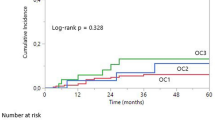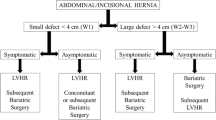Abstract
Background
Ventral hernia repair in obese patients has a high perioperative morbidity and recurrence. The laparoscopic approach may reduce those rates. This study compares those outcomes following laparoscopic ventral hernia repair (LVHR) with the standard open approach (OVHR) in obese patients.
Methods
A retrospective review of patients with a BMI > 30 kg/m2 that had undergone ventral hernia repair (VHR) between 2004 and 2012 was included. Demographics, perioperative complications and recurrence rates were compared between the two approaches. Hernia size was divided into three categories (small, medium and large). Physical examination and CT imaging mainly evaluated recurrences.
Results
A total of 186 patients that underwent VHR were included, 35 patients had LVHR. Groups did not differ in terms of age, gender, ASA score, BMI and in rates of primary or incisional ventral hernia repair. The laparoscopic repairs were performed on significantly larger hernias (48.6 vs. 28.9 % categorized as large, p = 0.02). The operative time was significantly longer in the laparoscopic repair (102 vs. 67 min, p < 0.01). Overall, perioperative complications following LVHR and OVHR were 17.1 versus 20.5 % (p = 0.53). Wound-related complications were lower in the LVHR group (5.7 vs. 15.8 %, p = 0.09). After a mean follow-up of 58 months, recurrence rates in the laparoscopic and open approaches were 20.0 versus 27.1 % (p = 0.28), respectively. Advanced age was found to be a significantly protector from recurrence (OR −0.03; 95 % CI 0.96–0.01, p = 0.01). OVHR carries an odds ratio of 2.7 (95 % CI 0.88–8.2, p = 0.07) for recurrence compared with OVHR.
Conclusions
The risk of recurrence after VHR in obese patients is high. Laparoscopic approach offers a better perioperative and recurrence outcome. We believe that change in those outcomes is possible through weight loss procedures, but may need further studies to be conducted in the form of prospective randomized trials.
Similar content being viewed by others

References
Mudge M, Hughes LE (1985) Incisional hernia: a 10 year prospective study of incidence and attitudes. Br J Surg 72:70–71
Park A, Birch DW, Lovrics P (1998) Laparoscopic and open incisional hernia repair: a comparison study. Surgery 124:816–821 discussion 821–812
Pierce RA, Spitler JA, Frisella MM, Matthews BD, Brunt LM (2007) Pooled data analysis of laparoscopic vs. open ventral hernia repair: 14 years of patient data accrual. Surg Endosc 21:378–386
Ramshaw BJ, Esartia P, Schwab J, Mason EM, Wilson RA, Duncan TD, Miller J, Lucas GW, Promes J (1999) Comparison of laparoscopic and open ventral herniorrhaphy. Am Surg 65:827–831 discussion 831–822
Lee J, Mabardy A, Kermani R, Lopez M, Pecquex N, McCluney A (2013) Laparoscopic vs open ventral hernia repair in the era of obesity. JAMA Surg 148:723–726
Heniford BT, Park A, Ramshaw BJ, Voeller G (2003) Laparoscopic repair of ventral hernias: nine years’ experience with 850 consecutive hernias. Ann Surg 238:391–399 discussion 399-400
Novitsky YW, Cobb WS, Kercher KW, Matthews BD, Sing RF, Heniford BT (2006) Laparoscopic ventral hernia repair in obese patients: a new standard of care. Arch Surg 141:57–61
Lomanto D, Iyer SG, Shabbir A, Cheah WK (2006) Laparoscopic versus open ventral hernia mesh repair: a prospective study. Surg Endosc 20:1030–1035
Israelsson LA, Jonsson T (1997) Overweight and healing of midline incisions: the importance of suture technique. Eur J Surg 163:175–180
Sauerland S, Korenkov M, Kleinen T, Arndt M, Paul A (2004) Obesity is a risk factor for recurrence after incisional hernia repair. Hernia 8:42–46
Tsereteli Z, Pryor BA, Heniford BT, Park A, Voeller G, Ramshaw BJ (2008) Laparoscopic ventral hernia repair (LVHR) in morbidly obese patients. Hernia 12:233–238
Raftopoulos I, Courcoulas AP (2007) Outcome of laparoscopic ventral hernia repair in morbidly obese patients with a body mass index exceeding 35 kg/m2. Surg Endosc 21:2293–2297
Birgisson G, Park AE, Mastrangelo MJ, Witzke DB, Chu UB (2001) Obesity and laparoscopic repair of ventral hernias. Surg Endosc 15:1419–1422
Bower CE, Reade CC, Kirby LW, Roth JS (2004) Complications of laparoscopic incisional-ventral hernia repair: the experience of a single institution. Surg Endosc 18:672–675
Rosen M, Brody F, Ponsky J, Walsh RM, Rosenblatt S, Duperier F, Fanning A, Siperstein A (2003) Recurrence after laparoscopic ventral hernia repair. Surg Endosc 17:123–128
Forbes SS, Eskicioglu C, McLeod RS, Okrainec A (2009) Meta-analysis of randomized controlled trials comparing open and laparoscopic ventral and incisional hernia repair with mesh. Br J Surg 96:851–858
Miles RH, Carballo RE, Prinz RA, McMahon M, Pulawski G, Olen RN, Dahlinghaus DL (1992) Laparoscopy: the preferred method of cholecystectomy in the morbidly obese. Surgery 112:818–822 discussion 822–813
Memon MA (1997) Review. Laparoscopic appendicectomy: current status. Ann R Coll Surg Engl 79:393–402
Colon MJ, Kitamura R, Telem DA, Nguyen S, Divino CM (2013) Laparoscopic umbilical hernia repair is the preferred approach in obese patients. Am J Surg 205(2):231–236. doi:10.1016/j.amjsurg.2012.02.022
Luján JA, Frutos MD, Hernández Q, Liron R, Cuenca JR, Valero G, Parrilla P (2004) Laparoscopic versus open gastric bypass in the treatment of morbid obesity: a randomized prospective study. Ann Surg 239:433–437
Frezza EE, Shebani KO, Robertson J, Wachtel MS (2007) Morbid obesity causes chronic increase of intraabdominal pressure. Dig Dis Sci 52:1038–1041
Wolfe BM, Belle SH (2014) Long-term risks and benefits of bariatric surgery: a research challenge. JAMA 312:1792–1793
Eid GM, Mattar SG, Hamad G, Cottam DR, Lord JL, Watson A, Dallal RM, Schauer PR (2004) Repair of ventral hernias in morbidly obese patients undergoing laparoscopic gastric bypass should not be deferred. Surg Endosc 18:207–210
Datta T, Eid G, Nahmias N, Dallal RM (2008) Management of ventral hernias during laparoscopic gastric bypass. Surg Obes Relat Dis 4:754–757
Raziel A, Sakran N, Szold A, Goitein D (2014) Concomitant bariatric and ventral/incisional hernia surgery in morbidly obese patients. Surg Endosc 28:1209–1212
Chan DL, Talbot ML, Chen Z, Kwon SC (2014) Simultaneous ventral hernia repair in bariatric surgery. ANZ journal of surgery 84:581–583
Eid GM, Wikiel KJ, Entabi F, Saleem M (2013) Ventral hernias in morbidly obese patients: a suggested algorithm for operative repair. Obes Surg 23:703–709
Disclosures
Dr. Dvir Froylich, Dr. Miriam Segal, Dr. Miriam Segal, Dr. Adam Weinstein, Dr. Kamal Hatib, Dr. Eitan Shiloni and Dr. David Hazzan have no conflict of interest or financial ties to disclose.
Author information
Authors and Affiliations
Corresponding author
Rights and permissions
About this article
Cite this article
Froylich, D., Segal, M., Weinstein, A. et al. Laparoscopic versus open ventral hernia repair in obese patients: a long-term follow-up. Surg Endosc 30, 670–675 (2016). https://doi.org/10.1007/s00464-015-4258-y
Received:
Accepted:
Published:
Issue Date:
DOI: https://doi.org/10.1007/s00464-015-4258-y



